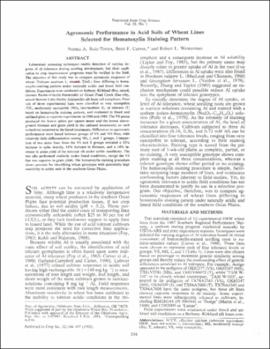| dc.contributor.author | Ruiz-Torres, Norma A. | |
| dc.contributor.author | Carver, Brett F. | |
| dc.contributor.author | Westerman, Robert L. | |
| dc.date.accessioned | 2015-10-16T20:47:49Z | |
| dc.date.available | 2015-10-16T20:47:49Z | |
| dc.date.issued | 1992-01 | |
| dc.identifier | okds_Carver_CS_1992-01.pdf | |
| dc.identifier.citation | Ruiz-Torres, N. A., Carver, B. F., & Westerman, R. L. (1992). Agronomic performance in acid soils of wheat lines selected for hematoxylin staining pattern. Crop Science, 32(1), 104-107. doi:10.2135/cropsci1992.0011183X003200010023x | |
| dc.identifier.uri | https://hdl.handle.net/11244/19795 | |
| dc.description.abstract | Laboratory screening techniques enable detection of varying degrees of A1 tolerance during seedling development, but their application to crop improvement programs must be verified in the field. The objective of this study was to compare agronomic responses of wheat (Triticum aestivum L. emend. Thell.) lines differing in hematoxylin- staining pattern under naturally acidic and limed field conditions. Experiments were conducted on Bethany-Kirkland (fine, mixed, thermic Pachic-Udertic Paleustolls) or Grant-Pond Creek (fine-silty, mixed thermic Udic-Pachic Argiustolls) silt loam soil complexes. Four sets of three experimental lines were classified as very susceptible (VS), moderately susceptible (MS), intermediate (I), or tolerant based on hematoxylin staining pattern, and evaluated in limed and unlimed plots as separate experiments in 1988 and 1989. The VS group produced the fewest spikes per square meter and the lowest above-ground biomass and grain yield in the unlimed treatments; no such reductions occurred in the limed treatments. Differences in agronomic performance were found between groups of VS and MS lines, with relatively little differentiation among MS, I, and T groups. Comparison of two sister lines from the VS and T groups revealed a 12% increase in spike density, 11% increase in biomass, and a 14% increase in grain yield of the tolerant sib under acidic conditions. The two sibs performed similarly under limed conditions, except the VS line was superior in grain yield. The hematoxylin staining procedure shows promise for identifying wheat genotypes with potentially high sensitivity to acidic soils in the southern Great Plains. | |
| dc.format | application/pdf | |
| dc.language | en_US | |
| dc.publisher | Crop Science Society of America | |
| dc.rights | This material has been previously published. In the Oklahoma State University Library's institutional repository this version is made available through the open access principles and the terms of agreement/consent between the author(s) and the publisher. The permission policy on the use, reproduction or distribution of the material falls under fair use for educational, scholarship, and research purposes. Contact Digital Resources and Discovery Services at lib-dls@okstate.edu or 405-744-9161 for further information. | |
| dc.title | Agronomic performace in acid soils of wheat lines selected for hematoxylin staining pattern | |
| osu.filename | okds_Carver_CS_1992-01.pdf | |
| dc.description.peerreview | Peer reviewed | |
| dc.identifier.doi | 10.2135/cropsci1992.0011183X003200010023x | |
| dc.description.department | Agronomy | |
| dc.type.genre | Article | |
| dc.type.material | Text | |
